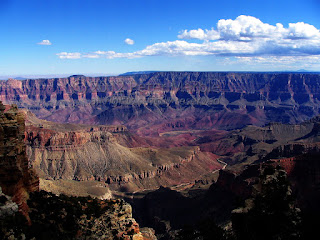After reading the first issue of my recently renewed subscription to Outdoor Photographer, I checked out the online version. I soon found Tom Till’s Digital Pitfalls: A Cautionary Tale in which he discusses coming to terms with the issue of “how much enhancement is too much”. This is something that many of us think about from time to time as we “tweak” our images in post-capture processing.
Included in the article, among others, is an image of Monument Valley Navajo Tribal Park which Tim used to illustrate how his approach to post processing has changed. That reminded me of our “Southwest Canyon Crawl” in September of 2004.
That May I bought my first digital camera — a Canon S1 IS. It was
somewhere between a DSLR and a point-and-shoot, featuring a whopping 3.2
megapixel sensor, 10x optical zoom, LCD viewfinder that flips forward
and rotates 270° (great for taking candid shots), and a full manual
mode.
Along with Monument Valley, we visited Zion Canyon:
Bryce Canyon:
and the Grand Canyon — This is the North Rim:
When I look back on my initial attempts to “touch up” my photos from that trip, I realize that I may have “overcooked” some of them. I attribute that, in part, to the simple fact that I had no idea what I was doing or really trying to achieve. In addition, my first editing software was Adobe Photoshop 7® which is not what I would call a particularly intuitive tool to use.
Here’s the out-of-the-camera shot of one of the buttes in Monument Valley:
Here’s what it looked like after I hacked away at it with Photoshop 7®:
And here’s what it looks like with some minor adjustments in Lightroom®:
Lightroom®, Nikon Capture NX® and other products, to mention just a few, provide us with the capability to sharpen, boost saturation, reduce noise, adjust the dynamic range of the shadows and highlights, etc.
It’s just so tempting and easy, and fun! But, where does one draw the line, if at all? Does it matter if the resulting image has no real connection with the original? For me, it depends.
When I submit an image to a microstock site, I know that I need to be very selective about my edits. I’ll add a bit of sharpening, adjust the levels, remove some noise and perhaps extraneous objects if I can get away with it, but that’s about it. Otherwise, the reviewers will reject it as having been over-processed and it will have been a wasted effort.
However, if I’m posting to this blog, or putting up a new gallery on petermarble.com, I allow myself far more latitude in terms of the adjustments I make.
I know there are some people out there who claim that a “real” photographer doesn’t need to do any post-processing. Personally I feel that anything goes, whether it’s using a split neutral-density filter before pressing the shutter release, or Lightroom’s graduated filter during post-processing to darken the sky. Either way, as a photographer you make a conscious decision that affects the final image. Who is to say what is too much processing? It is totally subjective.
Happy processing!
Subscribe to:
Post Comments (Atom)







No comments:
Post a Comment